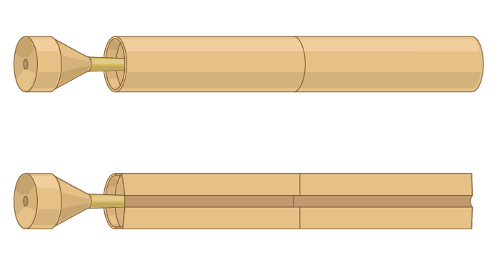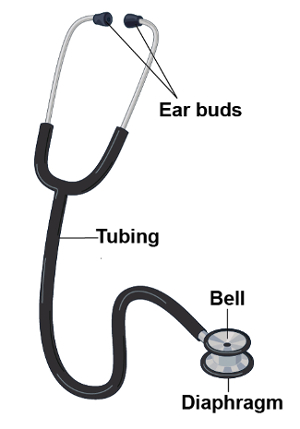听诊
来源:Jaideep S.Talwalkar,MD、 内科、 儿科,耶鲁大学医学院,纽黑文,康涅狄格
通过听诊,临床医师是能够"偷听的身体运作",获得重要的诊断信息。1从历史上看,"听诊"一词是"立即听诊,"其中考官的耳朵被放置直接对病人的皮肤的代名词。尽管几个世纪以来,这是标准的实践,证明不足在十九世纪的法国,由于社会规范和次优的诊断率的方法。这导致 René Laënnec 在 1816 (图 1),一种工具,已经在现代临床的实践,离不开听诊发明第一个听诊器和患者将其保留为荣誉和诚信的那些携带他们的象征。2

图 1。第一个听诊器由 René Laënnec 发明的代表性的插图。
听诊器 Laënnec 的初始空心木管以来经历了很多先进的技术。实际上来说,供应商必须了解现代听诊器胸件的两个方面的区别: 横膈膜和贝尔 (图 2)。

图 2。现代听诊器的部分。
应用时坚定地对病人的皮肤,横膈膜传输高频率的声音。从内病人的声音振动膜的横膈膜。这些振动会导致声音通过空气柱的里面听诊器,到考官的耳朵的传播。相反地,当应用轻轻,贝尔传输低频率的声音。钟作为直接把声音从病人通过听诊器的油管内传递一杯。紧迫更加牢固地与铃声可以舒展肌肤底层,本质上把它变成一个隔膜。听诊用于各种各样的临床的设置。它最常用在检查胸部、 心脏、 腹部和血管的作用。
- 整段的病人的遭遇,使用你的听力的非资助的感来标识可能诊断有用的结果 (例如,声音嘶哑或呼噜与到期)。
- 之前的病人接触,沾染 70%酒精纱布,规范可用的防腐冲洗手部卫生或医院表面消毒剂用于净化听诊器。3
- 听诊器的定位
- 将听诊器耳芽与提示指向前营造淹没了环境噪声密封放在你的耳朵。
- 哪一方的胸件 (即,铃声或横膈膜) 通过确认是活跃轻轻敲击一侧或其他。
- 直到你听到和感觉到点击切换响铃和隔膜所需旋转胸部一块。某些听诊器有只有一面到胸件,可以用作横膈膜和贝尔取决于对病人的皮肤应用的压力。坚定的压力使胸部片横膈膜,而轻压力使得它一口钟。
- 在你的惯用手举行胸部一块。有两个常用的拉手为胸件:
- 支持胸部片断之间的第二和第三个手指,用你的拇指下油管保持病人的皮肤,可以潜在地减少噪音工件塞中间指骨。
- 支持胸部片断之间的拇指和食指远端指骨。当使用这种握杆,掖剩余的手指下油管,以保持它关闭病人的皮肤,虽然在某些操作中,这些手指需要在稍微伸展,保持手指自己病人的皮肤
- Markel, H. The Stethoscope and the Art of Listening. New England Journal of Medicine. 354: 551-553 (2006)
- Jiwa, M., Millett, S., Meng, X., and Hewitt, V.M. Impact of the Presence of Medical Equipment in Images on Viewers' Perceptions of the Trustworthiness of an Individual On-Screen. Journal of medical Internet research. 14 (4), e100 (2012).
- Makim, D.G. Stethoscopes and Health Care-Associated Infection. Mayo Clinic Proceedings. 89: 277-280 (2014).
跳至...
此集合中的视频:

Now Playing
听诊
Physical Examinations I
60.0K Views

物理考试的一般方法
Physical Examinations I
115.1K Views

观察和检查
Physical Examinations I
92.9K Views

触诊
Physical Examinations I
82.4K Views

打击乐
Physical Examinations I
99.2K Views

病人的服装物理考试期间的适当调整
Physical Examinations I
82.9K Views

血压测量
Physical Examinations I
106.8K Views

测量生命体征
Physical Examinations I
113.5K Views

呼吸道考试 i: 检查和触诊
Physical Examinations I
155.6K Views

呼吸道考试 II: 打击乐和听诊
Physical Examinations I
211.2K Views

心脏考试 i: 检查和触诊
Physical Examinations I
175.0K Views

心脏考试 II: 听诊
Physical Examinations I
138.9K Views

心脏的考试 III: 异常心音
Physical Examinations I
91.1K Views

外围的血管考试
Physical Examinations I
67.6K Views

用连续波多普勒的外围血管考试
Physical Examinations I
38.3K Views
版权所属 © 2025 MyJoVE 公司版权所有,本公司不涉及任何医疗业务和医疗服务。